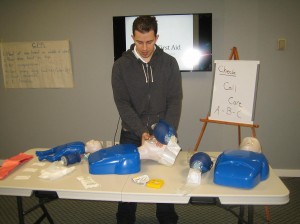
Standard first aid is the most popular program offered by Thunder Bay First Aid. Located in Ontario, Thunder Bay First Aid has been flocked by thousands of students each year to get certified and trained in this two-day training program that includes CPR and AED. Students can enrol in first aid, CPR and AED, and even food safety classes at this provider. On-line WHMIS, H2S Awareness, fall protection and confined space training are also provided. The class schedule is very flexible – classes are even available on evenings and weekends for participants that are unavailable to attend courses during weekdays. The Thunder Bay First Aid website has a complete list of programs and schedules, as well as an online registration form prospective students can use. Learn to manage emergencies such as shock, heart attacks, angina, stroke, hypothermia, burns, broken bones, external bleeding, head injuries, seizures, poisoning and many more by enrolling in a first aid course with this WSIB approved first aid training provider in Thunder Bay.
Convenient Enrolment
Students can enrol through e-mail or telephone call, as well as the online registration on the website. Walk-ins are highly encouraged by the staff as well, but be sure to conduct all your business with business hours. Any requests sent through e-mails and the registration form will only be processed during that time.
All training fees are also paid in full during enrolment so students don’t have to worry about incurring additional fees or expenses. The total fees include tuition, taxes, certificates, St Mark James registration fees, and training manuals.
Students who drop out are entitled to a full reimbursement, provided a notice was given to the staff at least 72 hours before dropping out of the program.
Top Notch Training

All classes and programs are taught by St Mark James certified trainers in high end training facilities. The Thunder Bay standard first aid first aid program is 18 hours long and offered multiple times per week. A lot of time is spent building a number of skills such as wound care and choking rescues. Cardiopulmonary resuscitation (CPR) training is also included, along with training in automated external defibrillators (AEDs). AEDs are machines that supply the heart with electrical shock during CPR.
CPR-only classes are also available, with three levels lasting 4, 5, and 6 hours long respectively. A and C are for first timers and HCP is for health care workers.
Certification
St Mark James certificate cards are awarded to student upon passing a program. To pass, a student needs to have attended all classes, get a 75 percent or higher in the written exam, and demonstrate good first aid skills. These cards are wallet-sized but bigger ones (wall-mount sizes) can still be requested.
While current and if prerequisites are met participants can take renewal or recertification program. Standard first aid recertification is 8 hours long, inclusive of CPR level C renewal.
Training facilities
All the facilities are equipped with high end equipment such as AED trainers, training mannequins, and first aid training kits. There are a few training centres located in Thunder Bay, all easily accessible. Students can reach the facility by public or private transportation. Restaurants, shops, and free parking are available near the facilities.
You can get a head start on your training below.
Did You Know?
If you have been diagnosed by eczema (atopic dermatitis), remember these simple lifestyle and home remedies to sooth the inflammation.
- Try to identify your triggers. This can be known allergens or even environmental conditions and stress.
- Apply calamine lotion or cream (or a similar product meant to soothe itchy skin) to the affected area.
- For severe itching, your doctor may prescribe an antihistamine.
- Do not scratch the skin. This can cause a wound and can lead to infection. Trim your nails or wear gloves at night.
- Cool compresses can be used to relieve any itching. Be sure to place a bandage over the area before applying a compress.
- Take a warm bath with baking soda and oatmeal.
- Keep skin moisturized.
- Wear cool, smooth clothing.